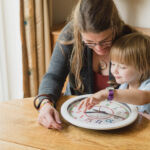
Is your child struggling to read an analogue clock? Perhaps you yourself have had trouble reading the time? For over 20 years, we have been working to make learning how to tell the time on a clock more accessible and enjoyable for children and adults. So, let’s take a look at our two intuitive methods for all learners and how these time-telling processes can transform the way your child understands time.
How to tell the time on a clock
Many children find it difficult to read the time on an analogue clock. This may be something that you have already noticed in your child, or it may be a concern that you are keen to address ahead of the new school year.
We identified these difficulties in children several years ago, and we worked with a group of children to identify the two key causes of their confusion and hesitancy. Both issues come from design flaws on the clocks themselves, as the first is regarding the limited information contained on the face of a clock.
First, regular clocks and watches typically display only hour numbers and some small markings to indicate minutes without actually displaying the 60 minutes within each hour. Whilst this is usually enough information for an experienced time-telling adult to gauge the time, it actually represents just 20% of the information needed to accurately read the time. The remaining 80% – including crucial context like minute details and clear hand positioning – is missing.
The second issue regards the hands of a clock. On most clocks the two hands are often nearly the same length which makes it confusing for people to determine which number to read first. They are also often positioned between numbers, rather than landing on a specific minute marker, which makes it even more challenging to accurately read the time. This lack of clarity makes learning to tell time challenging and frustrating for many children, and for those who struggle with dyscalculia or similar challenges, these struggles can continue long into adulthood.
EasyRead Time Teacher
This is where EasyRead comes in. Our clock face designs carry all the information that is needed to tell the time and each minute of the day is carefully enclosed in separate sections so that the tips clearly point to specific numbers
We also separate the hour and minute sections of the clock into two clear circles, and each hand is enclosed in its own circle to avoid any confusion. So, now that you are familiar with our design, it’s time to take a look at the two simple ways to read an EasyRead clock.
3 step process
Our first method follows the usual process of reading a clock – the ‘past & to’ method. This popular time-telling technique is the one taught in UK primary schools, so if you’re looking to support your little ones’ learning, this is a straightforward method that reinforces their new skills.
Step 1: First, look at the long hand and read the number at the end of it. This number represents the minutes.
Step 2: Next, state whether the minute hand is on the “past” side or the “to” side of the clock. This helps children understand whether the minutes are counting past the current hour or towards the next one.
Step 3: Finally, look at the short hand and read the number at the end to state the hour.
And there you have it! Simple, straightforward, and requiring no guesswork, our structured approach uses all the information available on the clock and makes telling the time an easy game of ‘say what you see’.
2 step process
Perhaps you tell the time another way – as if you’re reading a digital clock? We aim to make learning how to tell the time on a clock accessible for all, which is why we also offer 12/24 hour clocks which only require 2 steps to read.
Step 1: First, look at the hour hand and read the number that it is pointing to.
Step 2: Next, look at the minute hand and read the number at the end.
Say these numbers out loud as you read them to state the current time. For example, if the time is “1:52,” simply say “One, fifty-two.”
How to tell the time on a clock with EasyRead
Which of these methods will work the best for you? Refer back to them as needed and enjoy practising the right method for you with our full range.
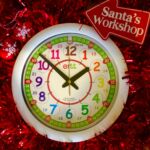
Are you looking for the perfect educational gift to put under the Christmas tree this year? Whether your little one has recently begun learning how to tell the time, or if you are planning on teaching them in the new year, a children’s wall clock is a meaningful and practical gift that will give them the best introduction to telling the time. With age-appropriate designs and engaging visuals, our children’s clocks include all the information a young child needs to begin learning how to tell the time, so read on to explore why one of our specialist learning tools should be on your Christmas shopping list this year.
Educational Design
Combining the joy of learning to tell time with a fun and colourful design, our EasyRead children’s clock is the perfect addition to any child’s bedroom or playroom. Designed with children in mind, and specially created to simplify the time-teaching process, our clocks feature large, easy-to-read numbers, and big black hands that clearly stand out against the colourful background to precisely demonstrate the exact time.
This simple and intuitive design makes it easy for children to practise telling the time and functions as an excellent educational tool for this essential life skill. Depending upon the requirements of your little one, our clocks are available with the two simple teaching methods ‘minutes past & to’; and ’12/24 hour’, and the EasyRead 2 or 3-step teaching method clearly leads your child through the process of learning to tell the time. This clear educational design also carries all the information children need to learn how to tell the time, including every hour and minute of the day on the 12/24 hour clock, whilst the minutes past & to design is clearly divided into 4 quarter-hour sections. Both of these methods allow children to quickly and easily identify the minute and hour hand, and to understand how both hands work together to demonstrate the passage of time, rather than simply reading the hands without understanding how they represent a specific moment in time.
Our designs go deeper than surface level reading, and with our easy teaching methods and visually-engaging, clear clock faces, your child will be able to learn how to read the time quickly and easily this Christmas.
Excellent Decoration
Our children’s wall clocks are not just learning tools to help your child develop their time-telling skills; they also serve as visually appealing decorations for your child’s room. With their bright and colourful design, our clocks are designed to make learning to tell the time an enjoyable and engaging experience for kids of all ages whilst helping to add a touch of fun and child-friendly decor to the room.
The clock is available in a range of colours and designs, so you can choose the perfect one to match your child’s room or personality, as well as their preferred time-telling method. Whether they would prefer a subtle, simple white design, or our red & blue or rainbow faces, our colourful design brighten up any bedroom, and the large face size makes it easy to read from across the room, giving your child access to the exact time no matter where they are in the room.
With bright colours and age-appropriate educational designs, our children’s wall clocks make learning to tell the time an enjoyable and engaging experience for kids of all ages, whilst helping develop their cognitive and organisational skills.
Establish Routine
As we all know, a child’s routine is created for them, either by a parent or carer, or by their nursery or school. As the majority of their time is planned out for them, children often don’t have a clear understanding of the passage of time or the significance of allocating time to different tasks throughout the day until they come to learn how to tell the time. By investing in a wall clock for your child, you can introduce them to these wider concepts in their own time, allowing them to develop their own understanding.
By having a visual representation of the passing hours on their own bedroom or playroom wall, children can establish a sense of routine and structure in their day as they learn to read the time. They can observe how their different activities correspond with the movement of the hands on the clock face, which is also an excellent way to introduce them to the concept of time management. This introduction can be particularly beneficial during the Christmas holidays, as the children will not have their daily routine from school or nursery and may be off their usual schedule. They can instead make their own, by allocating time for reading, playing, or spending time with family, or simply by observing the passage of time during the activities and explaining how much time has passed during each event. Similarly, the Christmas holidays are an excellent opportunity to use their free time to practise learning how to tell the time and to arrange a variety of festive time-telling activities, such as counting down how many hours until Father Christmas visits, or until they visit family on Christmas day.
Investing in a durable, reliable, and engaging clock that has been specifically designed to support children’s learning and development is an excellent way to prioritise your child’s cognitive development and time-telling skills. By introducing them to these skills now, you can ensure that they have developed a familiarity with the passage of time, and are ready to hit the ground running with their new skills once they head back to school or nursery, ready to build on their knowledge and excel at telling the time.
Give the gift of time with an EasyRead children’s wall clock
With its simple design, bright colours, and easy-to-read numbers, our EasyRead children’s wall clock is the perfect Christmas gift to support your child in learning how to tell the time. Our children’s wall clocks are designed with children in mind, helping your little ones develop essential skills while adorning their room with style, so why not add this engaging and practical educational gift to your shopping list.
Explore our range of children’s clocks today, or check out our EasyRead watches and alarm clocks for more excellent stocking fillers.

It’s important for parents to understand what their child is learning at school. It’s only natural that parents want to help their child be the best they can be. The early years at school are important to a child’s learning growth.
Key Stage 1
Year 1 Programme
In 2014, telling the time was introduced to the National Curriculum. In the early stages of Key Stage 1, children are required to tell the time to the hour and half past the hour and draw the hands on a clock face to show these times. What better way to introduce your child to the concept of time than having your own EasyRead Time Teacher wall clock in your house? The clear and colourful clock face is easy to read and our simple yet effective learning methods will have your child reading the time in a matter of hours.
Year 2 Programme
According to the year 2 programme of study, children should be able to count in multiples of 2, 3, 5 and 10 forwards and backwards. They should also be able to recognise, find, name and write fractions. Our wall clocks will not only help children with counting, they can also assist with fractions. The ¼, ½ and ¾ fractions are easily recognisable on the EasyRead clock face and will help your child understand fractions. In year 2, children are expected to tell and write the time to five minutes including quarter past/quarter to the hour. They should also know the number of minutes in an hour and the number of hours in a day.
Key Stage 2
Year 3 & 4 Programmes
Key Stage 2 builds upon the Key Stage 1 skills. Children will develop their fractions and counting skills. They will also learn to tell and write the time from an analogue clock. Children will also be expected to have a good concept of time. This means they will be able to estimate the time with increasing accuracy to the nearest minute. They will also use vocabulary such as o’clock, am/pm, morning, afternoon, noon and midnight. Our clocks are proven to help children at an early age to grasp the concept of time.
Our EasyRead Time Teacher wall clocks and watches are great for introducing your children to the concept of time so they are prepared for what they are going to be learning at school.
Click here to see the EasyRead wall clocks.
Click here to see the EasyRead watches.
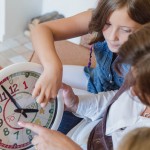
“Excuse me, do you have the time?” – A common question asked. What if you couldn’t answer that question? Well according to a poll by an on-line watch retailer earlier last year, one in seven people admit they can’t tell time on a non-digital watch.
More shockingly perhaps is the fact that in a different poll by www.TwistedTime.com, 37 per cent of parents with children aged 10 or under said they had not or did not plan to teach their children to read the time on non-digital watches. But why is this? Perhaps because people rely on getting the time from their phones and iPods rather than from watches and clocks.
Is it even necessary for 21st century children to learn how to tell the time on an analogue clock in today’s digital age? Well, yes! There are countless reasons:
- Analogue clocks can provide a vivid representation of time that digital clocks cannot. With many different learner types out there – including visual learners/thinkers – most need the analogue clock to have a good understanding of time. Children with autism spectrum disorders are an example.
- Telling the time is a useful skill and analogue clocks are still in use. It also provides a useful framework for understanding of modules and alternative numerical base systems.
- Are we going to replace the beautiful clocks on our churches and railway stations even the with digital? Surely not!
- “I’ll meet you at the train station at quarter past five” – this could be a problem if you can only use a digital clock!
- iPhones and iPods have an analogue clock option which is very popular amongst Apple users. Other companies such as Audi and Lexus also use the analogue clock rather than digital in some of their cars. Analogue still exists around us – and will continue to do so.
We are a family business dedicated to helping children and adults learn to tell the time on analogue clocks. Our clocks and watches are designed to help children learn to tell the time in terms of ‘minutes past’ and ‘minutes to’ the hour. Take a look at our 2 and 3 step teaching method.

Here at EasyRead Time Teacher, we love hearing feedback from our customers. We have always believed that our customers are our best advert. Take a look at what they are saying about EasyRead:
“The watch I ordered allowed my 9 year old dyslexic daughter to read the time like her classmates for the very first time! It has made such a significant difference to her life.”
“I would highly recommend this clock if your child has difficulty understanding how to tell the time – I wish I’d had something like this when I was a child!”
“My daughter has an EasyRead watch, we bought the matching clock and they really help with her understanding.”
“My five year old daughter learned to tell the time in five minutes!”
“Fantastic watch! My Granddaughter can’t wait to go to school wearing hers!”
“Excellent, daughter is very happy! She learnt time within two days. The watch is very sturdy, highly recommended.”
“Best watch I’ve ever purchased for my daughter.”
“What a brilliant watch!! So easy to read and builds children’s confidence. I would recommend this watch to everyone!”
“Great products and excellent quality for the money!”
Would you like to see what all the fuss is about? Click here to view all our EasyRead products.
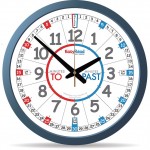
So you’ve bought your EasyRead Time Teacher clock…now what?
Practice makes perfect! Our clocks are designed to be taken off the wall and interacted with. Children will love the ‘hands on’ learning and then, seeing it every day up on the wall, they can practice and cement their learning.
We have even put the teaching methods on the back of the clock to make life as easy as possible! The simple design is brilliant for young children trying to get to grips with telling the time.
Take a look at our classroom clocks here.
Download our free resources here.
If you need any help or have any questions, please email us on [email protected] or call on 07865 470905.
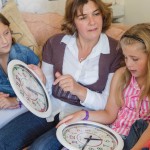
EasyRead Time Teacher believe in practice makes perfect. When children master something as difficult as telling the time, they need to cement that skill with practice. We have the solution.
Having an EasyRead classroom clock on your wall encourages children to practice on their own, in their own time. Children love to take ownership of their learning and will be running to the clock to practice their new skills!
As well as our brilliant products, we also offer numerous free learning resources such as clock colouring sheets, our two step and three step systems and our video library.

EasyRead Time Teacher is a family business dedicated to helping children and adults overcome the problems encountered when learning to tell the time.
The business was started by Roger Shackleton, who is based in Sydney and is a winner of an Australian Design Award. Roger designed the ‘EasyRead Dial’ and the ‘Three Step Teaching System’ after finding it extremely difficult to teach his own children to tell the time using regular analogue clocks.
Roger’s business started in 2011 under the name ‘Theme Time Australia’. In 2012 his sister, Sue Shackleton, who is based in Malvern UK, joined him to develop the business in the UK & Europe. EasyRead Time Teacher Ltd was formed in 2013.
EasyRead Time Teacher have expanded on the clock design and are now offering a range of watches and teaching resources as well as variations on the original clock design. Click here to look at all the products EasyRead have to offer. With over 50,000 worldwide sales and products available all over the world, EasyRead are growing rapidly and are trusted by hundreds of schools and thousands of families.
We couldn’t have done it without our amazing customers and distributors. Take a look at what our customers say about us.
If you would like to find out more about EasyRead or have any questions, please email us at [email protected].
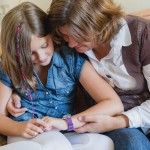
Children with dyslexia, dyspraxia and many on the autistic scale may struggle to learn to tell the time easily. They especially have problems telling the time on a clock with hands.
It may be that you can tell whole hours and half hours but not smaller chunks such as 8:04. People with S.E.N. might find it difficult to distinguish between the minute and hour hands. Also concepts such as ‘to’ and ‘past’ on a clock might be confusing.
As a parent, there are several ways you can help your children to learn to tell the time:
Our EasyRead watches and clocks are clear and colourful with a large dial showing every detail your child needs. Our simple yet effective three step teaching system makes it easy for children to learn to read the time in terms of ‘minutes past’ and ‘minutes to’ the hour. Our equally as effective two step system teaches children how to tell the time digitally.
Feedback from our customers indicates that our EasyRead clocks and watches really helped their S.E.N. children to learn how to tell the time.
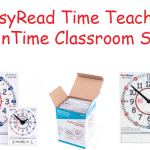
We had a great time at the BETT Show! Did you manage to visit us? Don’t worry if not, take a look at our great new products in action now:
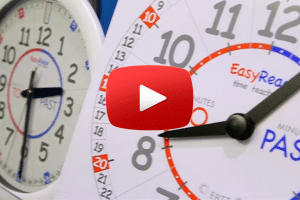
The new EasyRead TwinTime Classroom Sets are ‘hands on’ teaching resources for children learning to tell the time. They are double sided and feature an analogue clock face with independently moveable hour and minutes hands on both sides – perfect for teaching a classroom full of children. Teaching how to tell the time using both the digital and analogue methods is easy as one side shows ‘minutes past and to the hour’ and the other side shows ’12 and 24 hour time’.
Visit our website.










